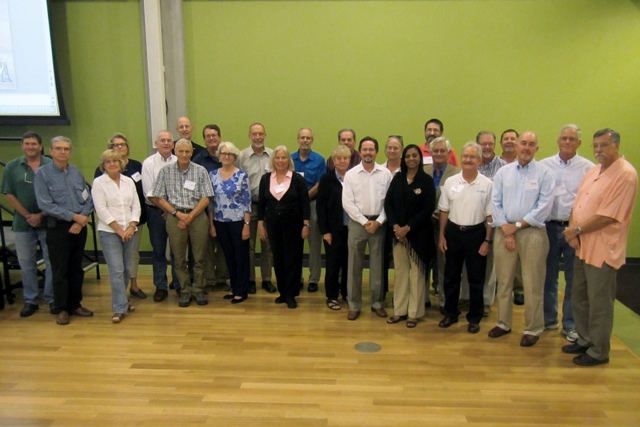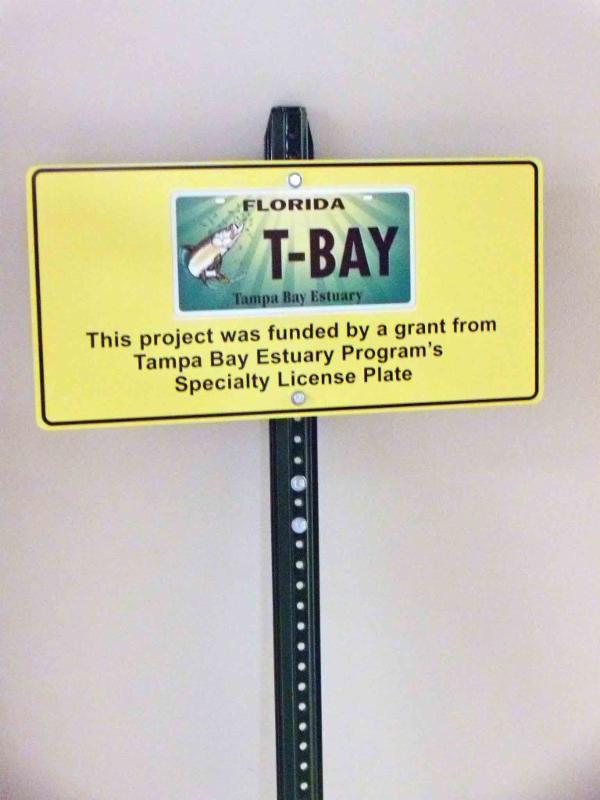Give A Day For The Bay
Volunteers Back in Action
 Our volunteers have been busy! Forty pe ople helped spruce up Clearwater's Moccasin Lake Nature Park in September. They pulled invasive plants like Caesar weed and rosary pea from the trail, cleared invasives from the butterfly garden and gave the exhibit areas a thorough washing! 
Our Cockroach Bay Aquatic Preserve workday in November also targeted invasive plants. Nearly 60 volunteers, including students from HCC and Eckerd College, worked with Hillsborough County staff to yank Brazilian pepper, Caesar weed and guinea grass from the restored tidal wetlands of this popular county preserve. Our next workday is December 12 at Robinson Preserve in Bradenton. In January, we'll be pitching in at Lowry Park Zoo, with March and April workdays after that at other locations. Want to join us at an upcoming workday? Sign up here. |

|
|
TBEP's Be Floridian Campaign:
"Protecting Fun" for Five Years
This fall, TBEP completed the fifth and final year of its innovative "Be Floridian" education campaign supporting local ordinances in Pinellas, Manatee and Tampa that restrict fertilizer use in summer.
Be Floridian used social marketing techniques, a plastic pink yard flamingo mascot, and a positive message to skip the fertilizer in the summer to protect the bays, lakes and rivers that make living here fun. The campaign embraced multiple platforms, including billboards, print ads, digital ads, vehicle wraps, community events, an extensive social media presence and a popular traveling flock of artist-painted yard flamingos that visited local tourist attractions and public facilities.

Evaluations show that Be Floridian made a measurable difference in changing awareness of fertilizer ordinances and practices to reduce nitrogen pollution in Tampa Bay and the Gulf of Mexico.
Some 52% of homeowners who took the final campaign survey in summer 2015 said they do not use fertilizer at all; less than 5% identified the months of June, July or August as the best times to fertilize, and most selected spring and fall months. 
Be Floridian will continue through the educational programming of several TBEP city and county partners, as well as local governments elsewhere in Florida who have adopted campaign messages..
The Be Floridian Facebook page will remain active through Spring 2016; visit us there for fun tips on "gardening like a Floridian."
|
|
TBEP Staff On The Go
|
| |
USF marine scientist Mark Luther with TBEP's Lindsay Cross and Holly Greening at the 2015 CERF conference.
|
Holly Greening, Ed Sherwood, Lindsay Cross, Misty Cladas and Nanette O'Hara gave presentations at the BASIS 6 Conference held at USF's St. Petersburg campus in September.(see adjacent article)
Holly, Ed and Lindsay presented at the annual Coastal Estuarine Research Federation (CERF) conference in Portland, Oregon in November. This large technical conference was attended by more than 1,500 coastal scientists, including many from the Tampa Bay region.
In September and October, Lindsay Cross gave talks about the potential impacts of sea level rise at Weedon Island Preserve and to the Barrier Islands Governmental Council in Pinellas County.
Lindsay also joined St. Pete Councilman Steve Kornell, a TBEP Policy Board member, in attending a Florida League of Cities training in Minneapolis in October.
Nanette O'Hara shared info about TBEP education campaigns addressing fertilizer use and pet waste with National Estuary Programs in Long Island Sound and New Hampshire.
|
| | Nanette O'Hara joins Jack Harris (left) and Mayor Bob Buckhorn for "The Mayor's Hour." |
Nanette, an avid saltwater angler, discussed Tampa Bay's remarkable seagrass resurgence and the importance of these "fish factories" with Tampa Mayor Bob Buckhorn and co-host Jack Harris on CTTV's "The Mayor's Hour" in October.
Ron Hosler attended the Florida Government Finance Officers conference in Palm Beach Gardens in November.
Ed Sherwood has traveled to the Long Island watershed twice in recent months to share info about TBEP's restoration and monitoring programs with scientists working to improve Long Island Sound.
In early December, Holly, Ed and Misty presented at the Association of National Estuary Programs' conference in San Juan, Puerto Rico. While there, they enjoyed the beautiful architecture of Old San Juan, including the Universidad Carlos Albizu, shown below in Christmas finery.
 |
|

|
|
|
|
2015: A Year To Remember!
More than 70 community leaders gathered at Tampa's Picnic Island Park in October to celebrate the recovery of bay seagrasses.
Before we dive into a new year, we'd like to take a moment to reflect on what was a truly momentous and eventful 2015 for TBEP and for Tampa Bay:
- We celebrated a milestone this year as bay seagrasses recovered to levels not seen in 60 years! Tampa Bay now harbors 40,295 acres of life-sustaining seagrass, surpassing the baywide goal of 38,000 acres set in 1995 by the TBEP.
- Through 2014, Tampa Bay met water clarity goals for all four major bay segments. This was the first time since monitoring began that baywide targets were reached for three straight years. The 2015 results, expected in January 2016, will likely show decreases in water clarity related to drenching summer downpours that produced some of the highest rainfall totals ever recorded in the bay watershed.
- August 2015 will live long in our memories as the region's "third wettest August since records began in 1890", according to the National Weather Service. Officially, 16.47 inches of rain fell on Tampa that month, with higher totals and widespread flooding in several areas. Any lasting effects of emergency sewage discharges and stormwater runoff on the bay's health may not be known for some time.
- TBEP received $2 million in settlement fines from the 2010 BP Horizon Gulf Oil Spill. We will use the funds to support seven habitat restoration and water quality improvement projects. Together, these projects will reduce nitrogen loadings to the bay by 16.5 tons per year, restore 268 acres of coastal habitats and foster 200 new acres of seagrass.
- We awarded $673,000 in funding for bay restoration and research through the Tampa Bay Environmental Restoration Fund, a collaborative grant partnership with Restore America's Estuaries supported by public and private sponsors.
- We launched a major, 10-year update of Charting the Course, our comprehensive management plan for Tampa Bay. This regional plan includes nearly 50 specific actions addressing all aspects of Tampa Bay, from reducing algae blooms, to protecting the bay's diverse coastal habitats, to ensuring adequate public access (see story and links below). The final document is slated for adoption in early 2017.
- An innovative study launched in Tampa Bay this year aims to quantify the ability of so-called "blue carbon" habitats like mangroves and seagrasses to absorb carbon and mitigate climate change. Mangroves, marshes and seagrasses may capture up to 50 times more carbon from the atmosphere than tropical rain forests, sequestering it in soils where it is less likely to impact global temperatures. TBEP is a key participant in this groundbreaking research led by Restore America's Estuaries.
|
Help Us Chart The Future of Tampa Bay
We are continuing to update our Comprehensive Conservation and Management Plan for Tampa Bay, called "Charting The Course."
 Drafts of several actions are being posted for review and comment here.
Actions addressing bay fish and wildlife, bay habitats and invasive species, already have been reviewed by TBEP's Management and Policy Boards. Next up are final Bay Habitats actions, as well as Dredging, Public Health and Toxics actions. New Action Plans are being developed for review quarterly.
The final document, slated for adoption in early 2017, will guide bay restoration, research and education efforts for the coming decade.
Your input is important to ensure we make meaningful and measurable progress in improving Tampa Bay. We look forward to hearing from you!
|
Conference Highlights New Technologies and Tools for Understanding, Improving Tampa Bay

The bay management community must continue to collaborate, share data and embrace new technologies for solving ever-more complex problems.
Those are key takeaways from the 6th Bay Area Scientific Information Symposium, held in St. Petersburg in September. Held every five years, this gathering of area scientists has provided an important venue to share research results, highlight successes and identify emerging issues that warrant attention.
Presentations covered topics as diverse as seagrasses, shoreline erosion, algae blooms, microplastics, the impact of sea level rise on coastal habitats, and community education. The value of remote sensing and other new techniques for detecting and managing ecological changes -- and even new and innovative approaches to engaging citizens -- was a common thread.
Other important conclusions of the conference:
-
A healthy Tampa Bay has enormous social and economic value.
-
Long-term monitoring programs are critical for tracking and recognizing trends in the diversity and health of the bay, and responding in a timely fashion.
-
Tampa Bay is a dynamic, constantly evolving system. Our regional strategies for bay recovery should be revisited periodically to take into account climate change and associated habitat changes as well as urban growth patterns.
-
The importance of seagrasses, marshes and mangroves in capturing and removing carbon from the atmosphere is a critical research area that can promote increased protection and restoration of those habitats.
-
Tampa Bay has an exceptional "knowledge pool" of scientific experts with a long history of working together across disciplines.
-
The active involvement of youth and community groups is vital to future success in protecting the bay.
Download and view BASIS 6 Power Point presentations and a conference synthesis here.
|
17 Community Groups Receive Bay Mini-Grants
Tampa Shores Receives Golden Mangrove Award
 Students from Canterbury School in St. Petersburg took part in hands-on learning activities about water quality, fish anatomy and health, and habitat restoration through a TBEP Bay Mini-Grant.
The Tampa Bay Estuary Program recently awarded $85,000 in Bay Mini-Grants to 17 community groups for projects that directly involve citizens in restoring and improving Tampa Bay.
Among the diverse projects funded for 2016 are outdoor classrooms and estuary field trips for area schoolchildren, shoreline plantings and invasive plant removal, expansion of shoreline cleanup programs, installation of stormwater prevention devices, and a shorebird and sea turtle educational toolkit.
Members of the Estuary Program's Community Advisory Committee evaluated 21 grant proposals, recommending 17 for funding. In addition to the traditional grants of $5,000 or less, three special habitat restoration projects will receive up to $10,000. Funds for the Mini-Grant program come from sales of the Tampa Bay Estuary license plate - also known as the "Tarpon Tag." of the Estuary Program's Community Advisory Committee evaluated 21 grant proposals, recommending 17 for funding. In addition to the traditional grants of $5,000 or less, three special habitat restoration projects will receive up to $10,000. Funds for the Mini-Grant program come from sales of the Tampa Bay Estuary license plate - also known as the "Tarpon Tag."
Grant recipients have up to one year to complete their projects.
Golden Mangrove Award
TBEP also honored the Tampa Shores Special Dependent District with its "Golden Mangrove Award" as the most outstanding Bay Mini-Grant project for 2014.
|
| |
CAC Member Kristin Lehman (right) presents Golden Mangrove Award to Tampa Shores residents Brad Ware and Susan Aungst.
|
This community of more than 200 homes in the Town n' Country area of Hillsborough County directly borders Upper Tampa Bay. The group was honored for an innovative project to reduce stormwater pollution by installing four sturdy baskets in existing stormwater drains to capture oil, trash and lawn clippings before they reach the bay. Community leaders recruited volunteers to clean out the baskets.
The neighborhood association also provided information to residents about the project, and how they can could help reduce pollution, through the Association's website, Facebook page, business meetings and social events. Tampa Shores has just been awarded another Bay Mini-Grant to support the installation of five more stormwater baskets in 2016.
|
| |
Installing stormwater baskets in
Tampa Shores
|
The Golden Mangrove Award was created by TBEP's Community Advisory Committee to recognize an
exceptional grant project. Tampa Shores was selected by CAC members from among 18 community-based Mini-Grants awarded in 2013-2014.
|
|
|
About the Tampa Bay Estuary Program
The Tampa Bay Estuary Program is an intergovernmental partnership dedicated to restoring and protecting Tampa Bay, Florida's largest open-water estuary. TBEP is one of 28 "Estuaries of National Significance" designated by Congress.
Our Policy Board is comprised of representatives from Hillsborough, Manatee and Pinellas counties; the cities of Tampa, St. Petersburg and Clearwater; the Southwest Florida Water Management District; the Florida Department of Environmental Protection; and the U.S. Environmental Protection Agency.
|
|
|